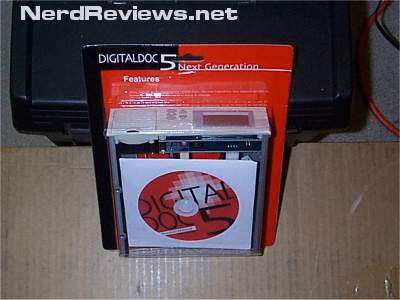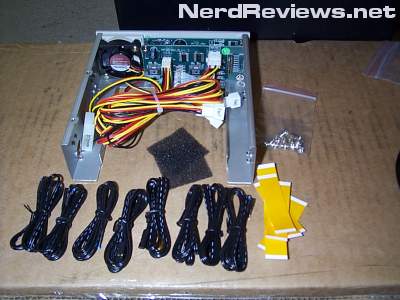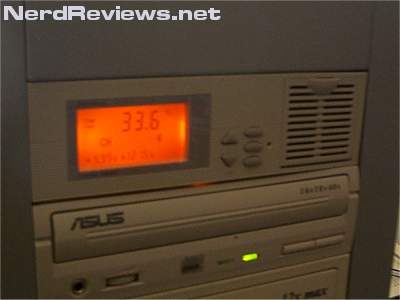Macpower Peripherals' Digital Doc 5 Review
By Bones (Ed T. Toton III)
September 26, 2002
Updated Oct 10, 2002
Updated Oct 27, 2003
(Review unit not supplied; purchased for use)
 DESCRIPTION
DESCRIPTION
With each passing year, keeping your PC cool becomes more and
more important. As processor speeds are continually pushed higher,
heat continues to become a bigger issue. But just how well is your
system managing it's heat? Sometimes that's hard to tell. Most
motherboards these days have a built-in BIOS feature for monitoring
CPU core temperature, but often it's difficult to access that information
while the system is running, unless the manufacturer was kind enough to
include a software program for that purpose, or makes other options
available (such as ASUS's iPanel).
The Digital Doc 5 (or DigiDoc or DigiDoc5 as it's often referred to) is
a temperature monitor and fan controller. Unlike many other temperature
monitors, this one does not have the shortcoming of relying upon internal
batteries for power, and it allows for 8 seperate sensors and channels.
Each one can be individually programmed for specific thresholds at which
an audible alarm will sound, or a fan will be activated. Likewise, up to
8 fans can be controlled (typically including the small 40m fan built into
the unit, however that is optional, and the new 'plus' version of the device
has USB and Firewire ports instead of a small fan). Fans can either be
controlled by the temperature monitors, or set to "always on". Individual
thresholds can also be set for the fans, to sound n alarm when their speed
falls below a certain number. The unit is also capable of monitoring the
voltage supplied by your power supply, and sound an alarm for that as well.
The device operates completely independantly of your processor, operating
system, etc. No software is required, and it will continue to function even
if your PC is malfunctioning, since it is a stand-alone unit. The included
CD is merely a documentation disc, containing a single PDF file.
The temperature sensors can easily be installed just about anywhere in
your case, since the leads are fairly long, and they give you ample-sized
pieces of thermal tape to affix them whereever you choose. Two of the
sensors are flat, and can thus be used to monitor chips. I wouldn't
recommend inserting one between your CPU and heatsink, since you don't
want to risk impeding the heat transfer, however it may be possible to
remove some of the plastic coating and fit the small wires between the
pins to attach the sensor to the underside of your processor, or you might
attach it to one of the fins on your heatsink.
The customization options and number of features that this unit comes
packed with is almost enough to make you forget the horribly ugly orange
color that they used for the backlighting, though with a little time and
effort, people have managed to customize the backlight to suit their tastes.
OBSERVATIONS
In operation, the device is quite effective. It cycles between the 8 channels
and displays temperature in either Celcius or Farenheit, as well as the voltages
being received, and a small indicator to show that the fan connected to that
channel is running. Channel numbers flash when there is a problem with the
temperature or fan speed.
Changing the settings is easy, and they're stored in an EEPROM and thus
only need to be done once. It'll remember your settings, so you don't have
to re-enter them every time you boot. The integrated fan also has a dust
filter, and there is a "force" button to activate all fans at once.
The only operational short-coming that truly stands out is the fact that
the fans are simply on or off. They are not speed-controlled, and since you
can only set a hard threshold number for their trigger temperatures, it's
presumably possible to have fans cycle on and off rapidly. Essentially,
if a sensor gets warm enough to activate a fan, it may not take much
airflow before the temperature drops just below the threshold again,
thus deactivating the fan, and so on. I haven't observed much of this since
I mostly keep my fans set to "always on". The new 'plus' version of the
DigiDoc (Digital Doc 5+) addresses this to some degree by allowing a
5% grace-zone between the 'on' and 'off' temperatures, so the fans don't
cycle too wildly. However you still can't control speeds, or have the
fans toggle between 'full' and 'half', which we think would be preferable
to simple on/off toggling.
 I don't know if it's just my unit, or something common to the DigiDocs, but
after a few days of continuous operation, my DigiDoc started displaying
clearly erroneous temperatures. The relative temps seemed right- the sensors
that should be warmer than the others clearly were, but the actual numbers
didn't make sense. In a room that is 75°F, its clearly not possible for
the sensors to be picking up numbers in the range of 55°F to 65°F,
In Celcius it's just as incorrect, since the device is doing the scale
conversions correctly. It's simply misinterpreting the sensors. (Just
a side note- the picture on the right shows the color as yellow, but the
picture further below more accurately shows the orange coloring of the backlight).
I don't know if it's just my unit, or something common to the DigiDocs, but
after a few days of continuous operation, my DigiDoc started displaying
clearly erroneous temperatures. The relative temps seemed right- the sensors
that should be warmer than the others clearly were, but the actual numbers
didn't make sense. In a room that is 75°F, its clearly not possible for
the sensors to be picking up numbers in the range of 55°F to 65°F,
In Celcius it's just as incorrect, since the device is doing the scale
conversions correctly. It's simply misinterpreting the sensors. (Just
a side note- the picture on the right shows the color as yellow, but the
picture further below more accurately shows the orange coloring of the backlight).
After speaking with MacPower's tech support, they
assured me that the unit was in fact defective and suggested getting
a replacement. Apparently they were somewhat surprised at the temperature
anomaly I was experiencing, which would lead me to believe it's not a common
defect. However, upon receiving the replacement, it immediately continued
misreporting temperatures, though not to quite the same magnitude (nothing
in the 50's this time, though plenty of 60's). Given that my voltages
off the power supply appear to be very precise, I'm inclined to think
that the DigiDoc is easily confused by ambient interference, perhaps from
the iPanel sitting next to it. If that's the case, then I feel that the
DigiDoc's numbers must be taken with a grain of salt, and should therefore
be treated more as a fan monitor/controller only, and not a scientifically
accurate temperature monitor.
Aside from that, the voltage and fan monitoring features have appeared to
work nearly flawlessly (except for momentary erroneous numbers from one
fan, which leads me to believe that it may be the fan's fault).
I've also noticed that the LCD is configured such that for an optimal viewing
angle, you need to be looking down at it slightly (about 30° from horizontal).
This means that if you use a tower case on a desk, unless you put it in the
lowest bays, you may not be able to read the display. Looking up at it at
the right angle can result in a seemingly blank display. It would have been
nice to have a contrast control, though I realize that's not a common feature
in inexpensive LCD devices. The quality of the LCD can be seen as either a
real shortcoming, or just a minor nuisance, since many other LCD temperature
monitor devices are much more well adjusted for typical viewing angles.
The Digital Doc does take some time to install, and it's best to plan out
how you want your cooling strategy to work before you dive in. It's not a
quick-and-easy install, but rather a more complex system for the hard-core
DIY (Do-It Yourself) crowd. In fact, if you're truly a DIY tweaking sort of
person, there are several how-to pages written by hobbyists who have changed
the backlight color, and even the polarizing filter to invert the black/light
portions of the display.
One of the major criticisms that people have had concerning the DigiDoc5,
aside from the non-aesthetic use of an orange backlight, is the relative
uselessness of the 40mm fan. Many have argued that a set of USB or Firewire
ports would be far more useful. The DigiDoc5+ addresses all of these issues
by including 2 USB ports and one Firewire port instead of the 40mm fan, and
it comes with a blue backlight.
Overall, I believe that this could be a decent solution for monitoring the heat
distribution in your computer, though the precision leaves much to be desired. Most
other thermal monitoring systems only support one or two sensors, and have no means
to react to it. Although it can't operate fans at partial speeds, the Digital Doc can
be programmed to suit your needs for regulating air flow. Hopefully the temperature
innacuracies I observed are not common in the entire product line, but even if they
are, you can just change the temperature thresholds accordingly and still use the device
effectively. However the price point is also a major consideration, since there are
other devices, such as the TTGI/SuperFlower Fan Master, that can be had for about
half to two-thirds of the DigiDoc's price, and still have certain advantages over
the DigiDoc.




Features/Specifications:
- 5.25" Bay Device
- 8-Channel Temperature Monitor
- 8-Channel Fan Controller
- 8-Channel Fan Monitor
- 5v & 12v line monitor
- Advertised spec of +/- 1 degree temperature accuracy (uhm, yeah)
- Integral 40mm Fan (or 2 USB + 1 Firewire port on the 'plus' model)
Pros:
- No batteries required.
- Monitors fans and temperature, and activates or deactivates fans accordingly.
- EEPROM storage of settings.
- Dust filter on internal fan.
- "Force" button to activate all fans for a quick cooling.
Cons:
- Backlight is orange (though it can be turned off).
- LCD has poor viewing angles.
- Accuracy is questionable based on our observations.
- No variable speed control of fans, just hard on/off.
- No contrast control for the LCD.
- Expensive compared to similar devices from othermanufacturers.
Macpower Peripherals, Digital Doc 5 page
Macpower Peripherals, Digital Doc 5+ page
|